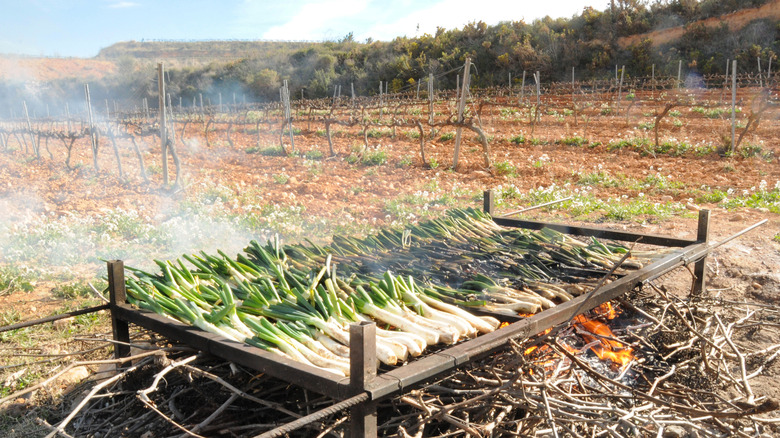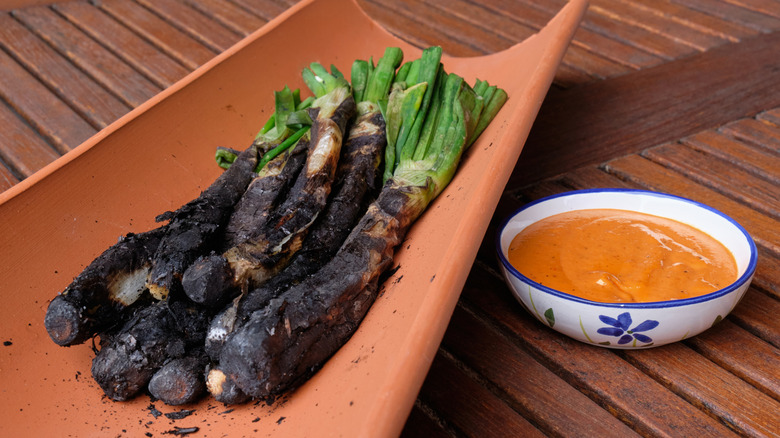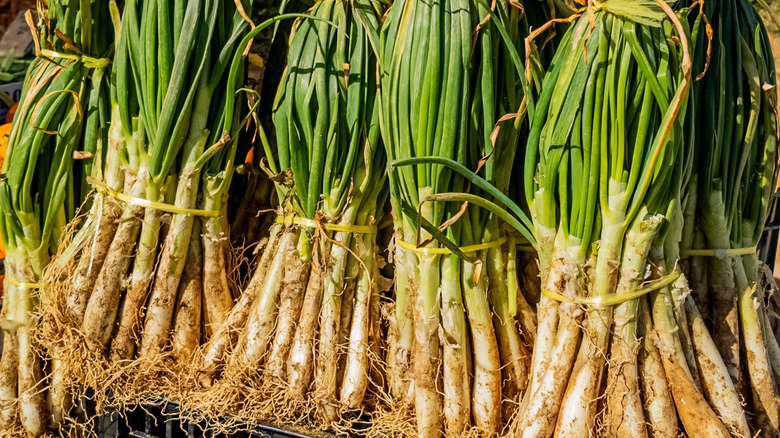One Of The Best Ways To Experience Barcelona Is Its Quirky Winter Gastronomic Festival
Winter is one of the most underrated times of year to visit Barcelona, not only because it's a good way to avoid crowds, but also because you will have the opportunity to participate in one of the Catalan city's favorite pastimes: the calçotada. Centered around the namesake "calçot," the calçotada celebrates the seasonal return of a regional green onion with a very mild flavor. They are grown in the southern parts of Catalonia, the autonomous region of which Barcelona is the capital. The onions are in season between November and April, with festivities across Catalonia in January to coincide with the harvest.
Though there are a few ways to cook these onions — and in my many years living in Barcelona I've seen them incorporated into unusual dishes like croissants and risotto — there is really only one way to have a calçotada. During these winter barbecues, which are usually held in private homes but might also be organized at big public street fairs, the onions are roasted over an open flame until the outer layer is completely charred. To eat a calçot, you have to rip off the blackened exterior with your hands, then find the nearest bowl of Romesco sauce so you can coat the onion in a tangy dip before dangling it into your mouth — just like the locals do.
Where to try calçots in Barcelona
If you are visiting Barcelona between January and March, you will see calçots being offered in Catalan restaurants all offered the city. They may pop up in ingredient lists here and there, but most of the time they are served as a part of a set menu that typically costs between $30-$50 and includes two or three courses, plus a drink that could be a wine or beer.
If you're wondering whether one restaurant will be typically good for its calçots, remember that as much as a calçotada is about the giant onions, it's also about the meat that goes on the grill. For this reason, you want to look for restaurants that also specialize in barbecue like L'Antic Forn, a cozy Catalan restaurant a few blocks away from the Barcelona neighborhood Las Ramblas (which locals avoid eating on), or Can Vador in the chic neighborhood of Eixample, where calçots are served alongside top-quality cuts of pork, lamb and local sausages. If you take a trip up to Montjuïc, Barcelona's fortress-topped mountain, you can also find Petit Hípica, which serves calçots al fresco in a beautiful location next to the botanical gardens. Because calçot season only comes once a year, it can be hard to get a table — especially on weekends — so make sure you get your reservations ahead of time!
Calçot day trips
Locals will tell you that the most important aspect of any calçotada is the countryside setting. While most visitors won't have quick access to their own casa rural, the typical pastoral vacation home, there are many ways to experience an authentic calçotada on a day trip from Barcelona, including a trip out for one of the largest parties of the year. Calçot season officially kicks off towards the end of January with the Gran Festa de la Calçotada, a one-day event that takes place in the town of Valls, a small town about 60 miles southwest of Barcelona. The festival is a blast if you can work it into your schedule, but you can also combine your calçot experience with a wine tasting in the Priorat region at restaurants like Canals & Munné in Sant Sadurní, a town reachable by train from Barcelona in one hour.
Or build up your appetite with a hike in Collserola Natural Park, the city's green lung, where you'll find many locals hiking on sunny winter days. Hidden in this 30-square-mile park are traditional restaurants that put on fantastic calçotadas like Can Martí or Can Cases, both of which offer incredible views of the mountain and urban landscapes. Many of these restaurants are accessible from park trails, so you can chart your course and look forward to a calçot feast at the end of a lovely hike.


